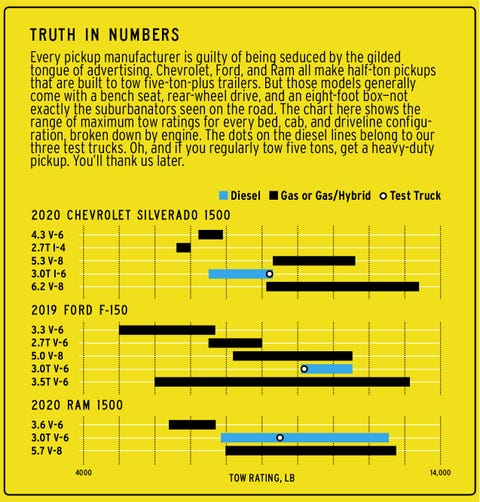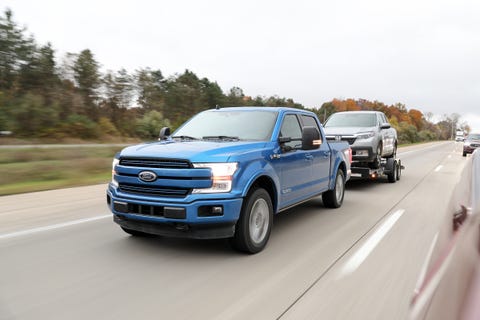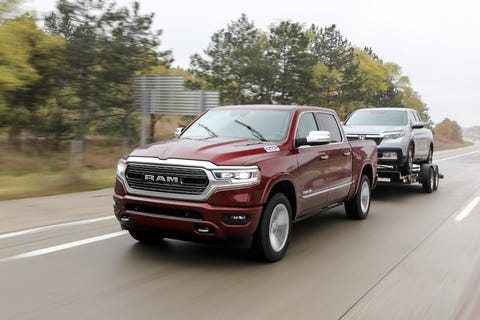We know what you’re thinking: Didn’t you just pick the Ram 1500 as a 10Best winner? Why are you comparing these trucks again so soon? Well, upsets happen all the time, and when you narrow the focus to a single model rather than the entire range, it’s possible that the Ford F-150 or Chevy Silverado 1500 beats the Ram. So we lined up the Big Three’s new half-ton diesels and let them slug it out.
It was a fair fight. We gathered four-door crew-cab versions with four-wheel drive and two-speed transfer cases, five-seat leather interiors, and five-figure asking prices that start with “6.” In other words: These aren’t strictly work trucks. These pickups fulfill a daily mission not unlike a large SUV, albeit with heftier towing capacities (see chart below).
A diesel in a Ram 1500 is nothing new. The EcoDiesel brand has already been through an emissions scandal involving its VM Motori–supplied 3.0-liter V-6. Unavailable last year, the turbo-diesel is back with a bit more power. It now makes 260 ponies and (more important to the coal-rolling community) 480 pound-feet of torque, gains of 20 horses and 60 pound-feet over the previous gen. The EcoDiesel, which comes with a mandatory 3.92:1 final drive, is a $5090 upgrade over the base gas V-6.
Ford was second to jump on the light-duty-diesel bandwagon when it began offering its own turbo 3.0-liter V-6 for the 2018 model year. The engine comes from Europe, a cousin of the turbo-diesel that Jaguar Land Rover installs in Range Rovers, among others. It is the weakling in this test, with 250 horsepower and 440 pound-feet. Ford complicates things by offering the diesel in different trims for different amounts. In our test truck, it’s a $4750 option.
Newest on the scene is Chevrolet’s—wait for it—3.0-liter six. Guess what? It was also developed in Europe, but unlike the others, it is wholly new and arranges the cylinders in a straight line. Just as Ford has repurposed the “Power Stroke” branding of its heavy-duty engine for its light-duty six, Chevy christens this turbo-diesel “Duramax” in the hope that you’ll make a mental connection to the 910-lb-ft monster that goes into the brand’s HD trucks. The Duramax makes the most power of the bunch, with 277 horses on tap, and the second-most twist, with 460 pound-feet. Also like Ford’s setup, the cost for the diesel option depends on trim. In a Silverado LTZ, it’s a $2495 charge.
The Ford and Chevy share a transmission, but you would never know it by driving them. It isn’t so much that the Ford’s version is conspicuous, it’s that the Silverado’s works as seamlessly as the inline-six that turns it. Chevy’s powertrain shines all the time but never so brightly as when it’s hooked to a 6650-pound trailer. If all we ever did with one of these trucks was tow, the Duramax might be enough to win us over. It is that nice.
The Silverado also tops a lot of objective stats, including payload, as-tested price, and acceleration. It is the lightest in the test, too, which pokes a rusty hole in Ford’s aluminum-body strategy. Even the fully kitted Ram 1500 is lighter than the F-series pickup.
But while this truck, equipped with the Duramax and the Z71 off-road package, rides better than other current-gen Silverados we’ve tested, it is no match for the Ram’s supple ride and adept handling. The scary thing for the competition is that the Ram isn’t just good for a truck; it’s just plain good. The F-150, on the other hand, never settles down. It bucks, wiggles, shimmies, and hops endlessly after an otherwise minor bump in the road. We thought attaching a trailer might calm the ride, but it didn’t.
Objectively, Ram’s EcoDiesel isn’t the best at doing truck things. As the charts reveal, the Ram’s payload is lower than the Chevy’s, and its tow rating is topped by the Ford’s. But the differences are negligible. About the only gripe anyone had with the Ram was its labored feeling when trying to keep a 70-mph pace with a trailer in tow; 65 was just fine.
The real knockout punch came at the fuel pump. Returning 30 mpg, the Ram bests its competitors by a wide margin. We should note that there is a slim but very real possibility that the Ram didn’t experience a single particulate-filter-regen event during the miles we logged. These periodic self-cleanings—think colon blow for your exhaust—consume extra fuel. Even if we doubled the worst-case scenario, adding half a gallon of diesel to our tally, the Ram would still have averaged a best-in-test 27 mpg. Towing economy was essentially a wash, with only a 1-mpg spread among the pickups.
In the end, this wasn’t anything more than a sparring match for the 10Best-winning Ram 1500. The upset will have to wait. We’re sure that Ford and Chevy will mount another title challenge soon enough.
3rd Place: Ford F-150 Power Stroke
Highs: Tow-capacity champ, aluminum body won’t rust.
Lows: Heavy despite prevalent aluminum, atrocious ride, chintzy interior.
2nd Place: Chevrolet Silverado 1500 Duramax
Highs: Velvety engine, silky trans, perfect brake feel.
Lows: Bland exterior, uninspired interior, can’t match the comfort of the segment’s best.
1st Place: Ram 1500 EcoDiesel
Highs: Remarkable ride and handling, as polished as a luxury car, sips fuel.
Lows: A little labored with a moderate trailer, but only a little.
From the February 2020 issue.
Tell us what you think. Write to: editors@caranddriver.com or join Backfires.caranddriver.com
Source: Reviews - aranddriver.com











